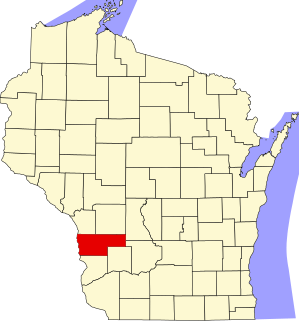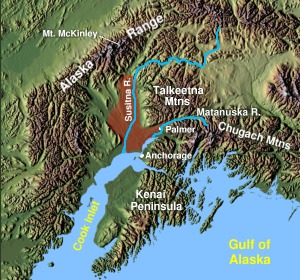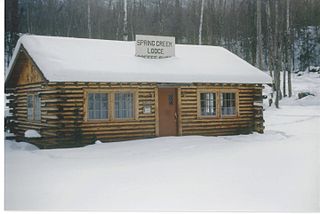
Palmer is a city in and the borough seat of the Matanuska-Susitna Borough, Alaska. It is part of the Anchorage Metropolitan Statistical Area. As of the 2010 census, the current population of the city is 5,937. The National Tsunami Warning Center is located in Palmer.

This is a list of the National Register of Historic Places listings in Matanuska-Susitna Borough, Alaska.

The Berry House is a historic house at 5805 North Farm Loop Road, near Palmer, Alaska. It is a simple 1+1⁄2-story wood-frame structure with a gable roof. It was designed by architect and community planner David Williams, and built in 1935 as part of the Matanuska Valley Colony project. Despite a rearward extension in 1971, the building is a well-preserved example of the type of housing built as part of this New Deal project. The house is named for James Berry, one of the project participants who was the house's third occupant.

This is a list of the National Register of Historic Places listings in Vernon County, Wisconsin, USA. It is intended to provide a comprehensive listing of entries in the National Register of Historic Places that are located in Vernon County, Wisconsin. The locations of National Register properties for which the latitude and longitude coordinates are included below may be seen in a map.
David Williams was an architect and community planner. He worked in the Washington, D.C. office of Federal Emergency Relief Administration (FERA).

The Bailey Colony Farm, also known as the Estelle Farm, is a historic Matanuska Colony farmstead that dates from 1935. It is located along the Glenn Highway near Palmer, Alaska in Matanuska-Susitna Borough. It was part of a New Deal program opening farms in Alaska as part of assisting overpopulated rural areas of the lower 48 states of the US, in a program conceived of by FERA architect David Williams.

In 1935, the Federal Emergency Relief Administration created an experimental farming community known as the Matanuska Valley Colony as part of the New Deal resettlement plan. Situated in the Matanuska Valley, about 45 miles northeast of Anchorage, Alaska, the colony was settled by 203 families from Minnesota, Wisconsin and Michigan. The colony project cost about $5,000,000 and, after five years, over half of the original colonists had left the valley. By 1965, only 20 of the first families were still farming the valley.

The Campbell House, also known as Colony House #54 and Campbell-Bouwens-Hamming House, is a historic house at 1540 Inner Springer Loop Road, near Palmer, Alaska. It is a simple 1+1⁄2-story wood-frame structure with a side gable roof. It was designed by architect and community planner David Williams, and built in 1935 as part of the Matanuska Valley Colony project. Of the 75 frame houses built as part of the colony, the Campbell House is one of the few that has survived, and is among the best-preserved. The Campbell House property also retains the original, now restored outhouse, and the chicken coop. At present time the Campbell House is the only colony home available to the public as a vacation rental.

The Curry Lookout, also known as Camp Regalvista, is an historic backcountry shelter in Denali State Park, Alaska. It is located on top of Curry Ridge, overlooking the Susitna River and the hamlet of Curry, a former depot on the Alaska Railroad. The only access to the shelter is via a 3-mile (4.8 km) hiking trail beginning at mile 137.2 of the Parks Highway. The shelter is a hexagonal wood-frame structure with a tent-shaped roof, and no foundation. Each side is about 6.5 feet (2.0 m) wide and 8 feet (2.4 m) high. A flagpole rises from the center of the shelter, and is secured to the structure via steel cables. The shelter was built by the railroad in 1923, the same year the Curry Hotel was built. It was intended as an excursion point for visitors, providing views of the surrounding area, including Denali.

The Fairview Inn is a historic hotel building on Main Street in the center of Talkeetna, Alaska, United States. It is a two-story frame structure, with a hip roof. The main block, 36 feet (11 m) square, was built between 1920 and 1923, following the arrival in the area of the Alaska Railroad. The building exterior is little-altered since then; its major modification has been the addition in the 1970s of an addition for owner living quarters. The interior also still follows essentially the same floor plan as when it was built.

The Herried House, also known as Grow House, is a historic house at 4400 North Palmer-Fishook Road, near Palmer, Alaska. It is a 1+1⁄2-story log structure, built from pre-cut logs that were assembled on site. The walls are three-sided logs, notched at the corners, with the gaps filled by burlap and caulking. To the west side of the main block is a wood-frame garage which has log siding. The house was built in 1935 by the Works Progress Administration as part of the Matanuska Valley Colony, and is one of its best-preserved survivors. The first owners, Leonard and Ellie Herried, lived there 1935–38.

The Wasilla Community Hall, also known as the Wasilla Museum, now hosting the Dorothy G. Page Museum, is located at 323 Main Street in Wasilla, Alaska. The museum is located in a log building constructed in 1931 to serve as a community center. The exterior of the building was left largely as-is when it was converted to a museum in 1967. The interior houses displays about the history of the city of Wasilla.

The Knik Site, also known as the Old Knik Townsite, is the location in Matanuska-Susitna Borough, Alaska that was once home to the largest settlement on Cook Inlet. The only surviving remnants of the community are a former log roadhouse, now a museum operated by the Wasilla-Knik Historical Society, and a log cabin. The Knik area had long been a meeting point of Native Alaskans, and in 1898 it became the principal community on Cook Inlet from which goods were shipped into the interior. In 1916 the Alaska Railroad reached the site of present-day Anchorage, bypassing Knik and leading to Anchorage's growth. When the railroad reached Wasilla, Knik lost all importance as a transshipment point, and its buildings were either abandoned or moved to one of the other communities. Knik is located about 13 miles (21 km) southwest of Wasilla.

The Talkeetna Historic District encompasses several blocks of the historic village center of Talkeetna, Alaska. It includes buildings on Main Street, roughly between C and D Streets, along with a few buildings on C and D Streets between Front and East First Streets. The village was established in 1916 as a regional construction headquarters of the Alaska Railroad, and became a home to area miners after the railroad's completion. The district includes three buildings that date to the time of the railroad construction, and another ten that were built before 1940. Most of the buildings in the district are one or two stories in height, and are either of wood frame or log construction. Notable among them are the Fairview Inn, the town's first schoolhouse, now the Talkeetna Museum, and the Talkeetna Roadhouse, which was built as a residential log house in 1917 and expanded in the 1940s to serve as a roadhouse.

The Spring Creek Lodge is a historic former restaurant at 18389 Old Glenn Highway in the Chugiak area of Anchorage, Alaska. Vernon and Alma Haik built the Spring Creek Lodge in 1949. It served as an essential eatery and community center in southcentral Alaska from 1949 to 1974. The lodge was famous for its homemade bread and banana cream pies, and it was the place to go for a hearty Sunday dinner. For 25 years, the lodge served homesteaders, hunters from the Matanuska Valley, and military personnel from the Elmendorf Air Force Base and Fort Richardson in Anchorage. The lodge stands at Mile 20 on the two-lane Palmer Highway halfway between Palmer and Anchorage. It also served as the first community center for the early settlers of Chugiak. On September 9, 2001, the Spring Creek Lodge was inducted to the National Register of Historic Places "in recognition of its contributions to the cultural heritage of Alaska." The restaurant was a local landmark until its location was bypassed by the new Glenn Highway in 1969, after which it closed.

The Matanuska Colony Community Center, also Palmer Historic District, is a cluster of buildings near the center of Palmer, Alaska that were the centerpiece of the Depression-era Matanuska Valley Colony. This federal rural resettlement program was intended to give needy families resources and land to improve their condition. The colony's buildings were erected beginning in 1935, and those that survive represent a well-preserved example of government community planning. It is centered on a city block bounded by East Dahlia Avenue, South Valley Way, South Denali Street, and East Elmwood Avenue, and extends to the north and south. The buildings on this block are organized around a grassy quadrangle, laid out in 1935. Prominent buildings include the Palmer Depot and three churches, located in the block just southeast of the quadrangle, one of which, the United Protestant Church, is a distinctive log structure. The colony's Central School, now added to several times, houses the offices of the Matanuska-Susitna Borough.

The Patten Colony Farm is a historic farm property in Palmer, Alaska. It is located near milepost 39.9 on the Glenn Highway, and is a relatively complete instance of a farmstead established in the 1930s as part of the Matanuska Valley Colony initiative. The complex consists of eight buildings, six of which were built in the 1930s. The main house is an L-shaped log structure with a concrete foundation, a rarity in the colony. Smaller outbuildings include a log outhouse, a chicken house, and two barns, one of which is the only surviving horse barn of the colony.

The Raymond Rebarchek Colony Farm is a historic farm property on Rebarchek Avenue in Palmer, Alaska. It consists of a 40-acre (16 ha) tract of land granted to Raymond Rebarchek in a 1935 land lottery organized by the Matanuska Valley Colony, a Depression-era agricultural colony project. The property was listed on the National Register of Historic Places in 1978. At that time, the farm complex included ten buildings, including Rebarcheck's original log house, a dairy barn, a well house, a greenhouse, and a chicken house. Only the original farmhouse, silo, and milking parlor are still standing today. The Alaska State Fair purchased the property in 2002 and is contemplating the establishment of a demonstration farm there.

The Puhl House, also known as the Bacon House, is a historic house at the corner of Scott Road and Glenn Highway in Palmer, Alaska. It is a rectangular single-story log structure measuring 35 by 25 feet, built out of round logs joined by saddle notches at the corners. The diameter and length of the logs reduces as they rise to the eaves; oakum chinking is used to close the gaps. The house was built in 1935 by Joe and Blanche Puhl, settlers who were part of the Matanuska Valley Colony settlement project. This building is distinctive as a colony house because it was not built by the crews of the Works Progress Administration that built most of the colony's housing; the Puhls organized their own construction team and acquired materials for its construction on their own.

The Old Willow Community Center is a historic community building on West Willow Community Center Circle, off mile marker 69.7 of the Parks Highway in Willow, Alaska. It is a single-story log structure, measuring 60 by 40 feet, built out of local spruce. It is covered by a broad aluminum gabled roof; the gable ends are finished in wooden shingles. The interior consists of a single large chamber. The building was constructed in 1961 as part of a community drive for a meeting space that was more spacious than the local railroad station. In 1992, it was moved a short way south of its original location, where the new community center and library now stand. The building continues to be used for community events.
















